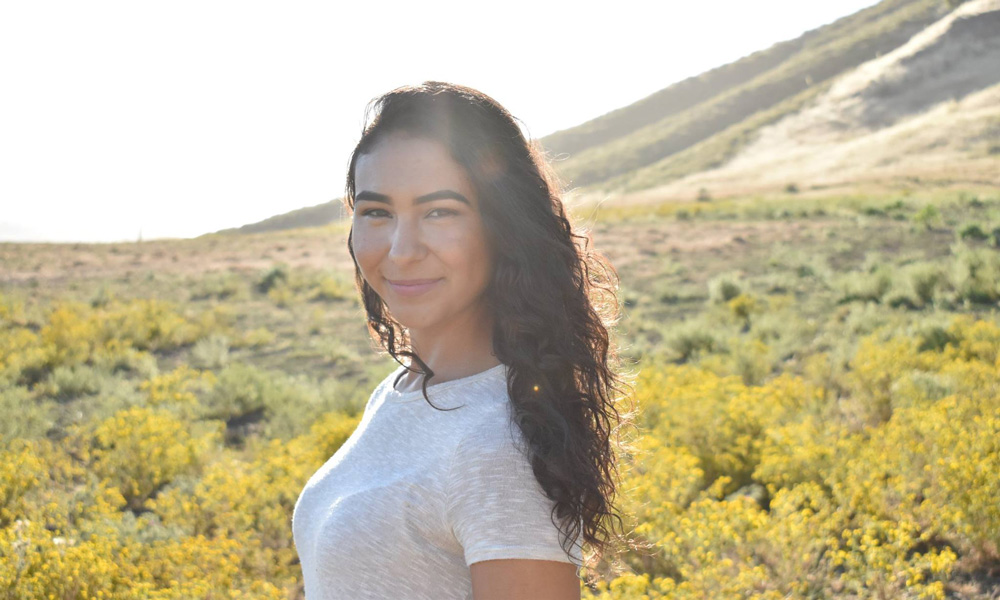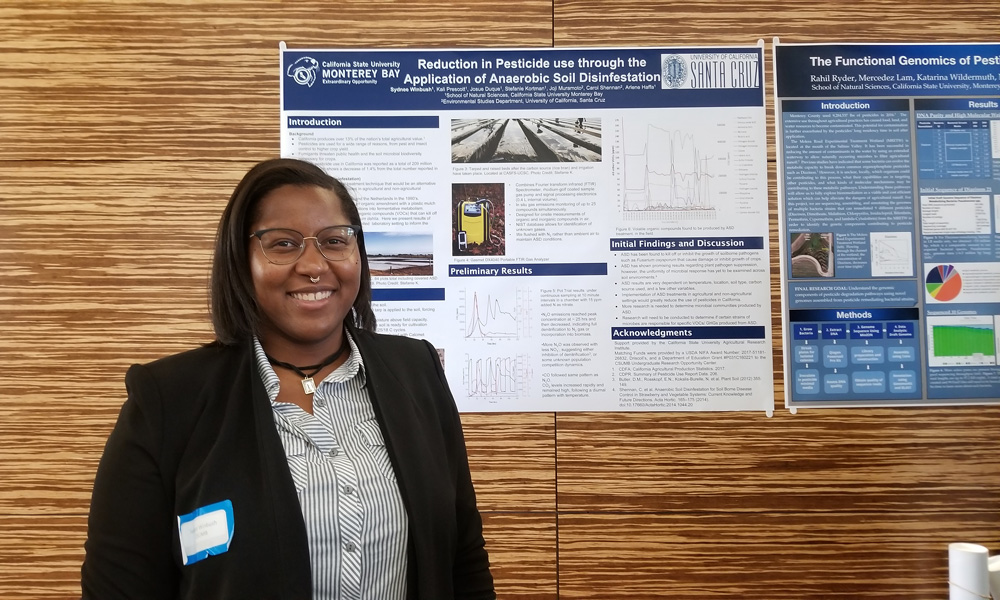The Agriculture Research Institute (ARI) engages the collective expertise of CSU colleges of agriculture and other related programs across the CSU, in partnership with agricultural and natural resource industries, to conduct applied research that benefits California agriculture, natural resources and food systems while cultivating the next generation of agricultural leaders.
Biomass-To-Energy—Carisse Geronimo’s Research Helps Fight Climate Change

Clean power sources, such as wind, solar, hydropower and biomass-to-energy, will provide all of California’s energy by 2045. In 2018, 91 biomass power plants in California produced about three percent (5.9 gigawatt-hours) of the state’s power from biomass conversion. Primary sources of biomass are byproducts and waste from agricultural crops, lumber milling and forest residues.
Climate change has increased the frequency and depth of drought, destroying tens of millions of trees in California forests. Left standing, these dead trees fuel and increase the risk of larger and more deadly forest fires. The dead trees can be harvested, processed and shipped to biomassconverting power plants, where they are stored in enormous chip piles. Over time, the chips slowly decompose, changing their physical and chemical properties and energy content. Carisse Geronimo, a master’s student at Humboldt State University, is working on a research project that will help biomass plants manage their chip piles to retain or improve the energy content of the wood chips to ensure this biomass source remains economically competitive.
Geronimo has always liked science and math. While growing up in Bakersfield, she spent a lot of time hiking in the San Gabriel and Sierra mountains with her dad. When it came time for college, she wanted a major that would allow her to combine science with resource conservation and sustainability. Geronimo started as a chemistry major at CSU Bakersfield and worked in a biochemistry lab during her sophomore and junior years. Under the direction of Dr. Karlo Lopez, she studied structure and function of lysyl oxidase, an enzyme that inhibits cancer cells during cancer’s early stages, but at later stages appears to promote metastasis. By her junior year, Geronimo had second thoughts about a chemistry degree and changed her major to biology.
After Geronimo graduated from CSU Bakersfield in May 2018, she found a program at the Schatz Energy Research Center at Humboldt State that combined the technical side of science with science advocacy and policy. She applied for, and received, the Donald and Andrea Tuttle Fellowship for Clean Energy Studies. This scholarship supports students interested in reducing the effect of climate change on humanity and ecosystems. She is working under Dr. Sintana Vergara and Dr. Kevin Fingerman, both faculty research associates at the Schatz Energy Research Center.
Geronimo started work on a biomass feedstock project in fall 2018. The project, co-funded by the CSU Agricultural Research Institute, seeks to understand what factors affect the decomposition and energy content of wood within these enormous wood chip piles. In her experiments, chips of various ages and tree species are subjected to different temperatures, moisture content and oxygen concentrations, and their decomposition rates and energy content are measured. Geronimo’s group monitors the physical and chemical properties of the wood chips that, during decomposition, emit greenhouse gases (carbon dioxide, nitric oxides and methane). She has found that the energy in biomass feedstock is related to its moisture content and age of the chip. As the wood decomposes, energy is released into the atmosphere, lowering the economic efficiency of the biomass plant. Geronimo’s experiments will provide insight on how to manage the decomposition process and retain heating value, energy content and reduce greenhouse gas emissions. Their early data indicate that separating chips by age, instead of mixing them, may be the easiest and most effective way to retain energy value.
Upon graduating, Geronimo would like to continue with similar environmental science-related work. Her long-term goal is to use her science knowledge and training to help inform public policy.
From A Stable to the Laboratory Bench, Gabi Hernandez’s Unexpected Path to a Research Career

Gabriella “Gabi” Hernandez grew up riding horses in Chino Hills, California. When not in school, Hernandez spent her time at the Silver Rose Ranch, where she boarded her horse, gave riding lessons and helped teach at the ranch’s summer camps. From an early age, Hernandez planned to be a large-animal veterinarian. Upon the advice of an alumna from California Polytechnic State University, San Luis Obispo, she met at the ranch, Hernandez applied to and was accepted into Cal Poly San Luis Obispo. During her sophomore year, she started working at the Cal Poly feed mill, where she mixed food rations for the farm animals, drove forklifts, moved and stacked 50-pound feedbags and learned about food safety and Hazard Analysis Critical Control Points, a systematic approach to the identification, evaluation and control of food safety hazards. She participated in research studies and was responsible for adding supplements to feed. These studies required careful weighing, dosing and recordkeeping, which fit well with her detail-oriented personality, and she loved the challenge of the research and its additional responsibilities.
Cal Poly San Luis Obispo’s animal science curriculum requires students to take a variety of classes, including enterprise classes, which allow students to discover the breadth of careers beyond veterinarian medicine. Enterprise classes are “learn by doing” educational experiences. In an enterprise class Hernandez affectionately called “Swine 101” (formally “Animal Science 290— Swine Management”), she learned just about everything about swine by raising her own pigs.
Swine 101 and Hernandez’s job at the feed mill converged during her junior year, when she took an advanced animal science nutrition class. The professor, Dr. Rodrigo Manjarin, assigned reading assignments from science journals and asked students to submit written responses that included analyses and discussions of the research methods and conclusions described in the papers. Dr. Manjarin liked Hernandez’s writing and critical thinking skills and suggested that she consider a career in research. He also suggested a research internship with Dr. Lindsey Hulbert at Kansas State University through Cal Poly San Luis Obispo’s Summer Undergraduate Research Program (SURP). Dr. Hulbert’s research centered on the development and validation of automated technologies to monitor health and welfare of domestic animals. Hernandez learned a lot about animal behavior, particularly pig behavior, but concluded this area of research was not going to be her career. Being far from home and school was both challenging and rewarding. She felt out of her comfort zone, without friends and family, but she said it helped her mature. She highly recommends an away-from-home research experience to her fellow students.
During Hernandez’s senior year, Manjarin asked her to stay at Cal Poly San Luis Obispo to pursue a master’s degree. Her research project, co-funded by the CSU Agricultural Research Institute, examined the effect of probiotics in protecting early weaning pigs from nonalcoholic fatty liver disease (NAFLD).
During pig production, newborn pigs may be weaned early to increase sow productivity. To increase their appetite, piglets are given sweeteners, which can cause an imbalance of their gut microbiota that results in diarrhea. Probiotics may help protect against the diarrhea and result in better piglet health and growth. Manjarin’s research team hypothesized that the high sugar diets of the weaned piglets might lead them to develop a pattern of liver injury resembling pediatric NAFLD, and studying the effects of these diets in Iberian pigs may lead to insights into this disease in humans. Hernandez ran the Iberian Pig Enterprise, overseeing a team of undergraduates to feed the pigs every six hours for 10 weeks and weigh the pigs every three days. Their research found that neonatal Iberian pigs fed a high-fat, high-fructose diet developed a pattern of liver injury resembling pediatric NAFLD, confirming that these animals could be used as a translational model to understand the disease in humans. The second part of Hernandez’s study was to determine whether a mixture of probiotics added to the pigs’ feed would prevent the disease. The team found that probiotics did not prevent NAFLD from developing in pigs nor did it ameliorate its severity.
Hernandez completed her master’s degree in summer 2019. Through her academic career at Cal Poly San Luis Obispo, she learned that she enjoyed managing people and had good interpersonal skills. She is now working as a research assistant at JustFoodForDogs, a Southern California company that offers fresh whole food pet food. Hernandez helps conduct research and testing of their products to ensure their claims are backed by data. She also is part of a custom formulation team, where she helps owners understand the nutritional needs of their pets and to find the best diet that addresses the pet’s health needs. Hernandez said she is definitely using what she learned through her master’s degree program, and enjoys her job. Her goal upon graduation was to find a job in clinical and life science where she could combine her science knowledge with her desire to communicate science to nonscientists, specifically in industries where expert knowledge is needed to help develop or market products. This job is a promising start to fulfilling that goal.
Sydnee Winbush Helps Discover Bacteria That Degrade Pesticides

Sydnee Winbush grew up in the Moreno Valley in Southern California. Always interested in life sciences, she took an advanced placement human anatomy and physiology class in high school. All the laboratory classes she was taking and her watching “Untold Stories of the ER” on TV convinced her she should go to medical school. Admitted by CSU and University of California schools, the biology major chose California State University, Monterey Bay. She liked the location, weather and how welcomed she felt there.
Winbush took a biochemistry class with CSUMB instructor Dr. Arlene Haffa and was invited to work in Dr. Haffa’s lab. Winbush’s first research project, co-funded by the CSU Agricultural Research Institute (ARI), focused on pesticide bioremediation. When insecticides are used to control pests in agricultural crops, they can end up in the soil. Over time, sunlight and microbial activity degrade the insecticides. Haffa’s team hypothesized that if they could select bacteria that were particularly good at degradation, bacterial strains could be used to help rid soils of pesticide residues. They knew that most bacterial species cannot break down insecticides, but a few can, and these were the ones they wanted to identify.
Haffa’s team is working with Dr. Nathaniel Jue, also at CSUMB, who is using metagenomics and bioinformatics to identify the pesticide-degrading bacteria and discover the genes and metabolic pathways that allow these bacteria to live in pesticide-laden soils. This research is on-going, but they have already identified several bacteria taxa that appear to have pesticide degrading capabilities.
Winbush worked on a second project co-funded by the ARI in which the team monitored soil anaerobic disinfestation. The idea was to force the soil to become anaerobic, which they theorized would decrease or eliminate pathogens. They accomplished this by adding a carbon source (rice bran), a potassium nitrate solution to the soil, and covered it with a thin plastic film to promote high temperatures (solarization) and inhibit oxygen, and left it on the field for three to six weeks. During this process, they monitored the gases emitted, as well as any greenhouse gases or volatile compounds emitted from the soil.
Before working in Haffa’s lab, Winbush had no idea this type of research existed, let alone that she would be involved in it. She appreciated that under Haffa, she had a lot of independence but also tremendous responsibility to learn about her project, to read the scientific literature and to figure out how to solve the problems related to research projects. These aspects of the research experience were never replicated in any of her classes. Working on agricultural projects was an unexpected turn that made Winbush realize the benefits of agriculture and the challenges in producing food. Now aware that a career in the agricultural industry could be interesting, she has explored those possibilities as an alternative to a career in human medicine.